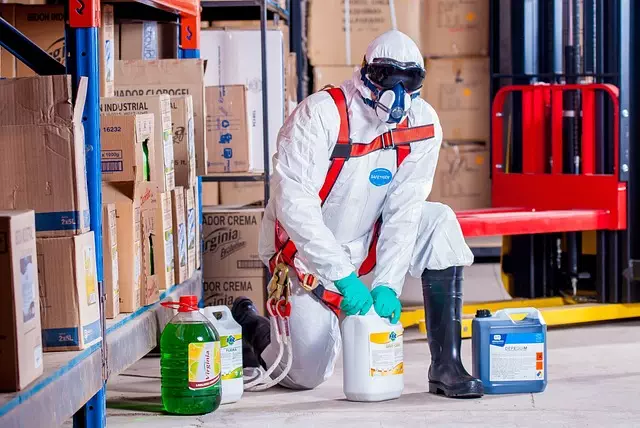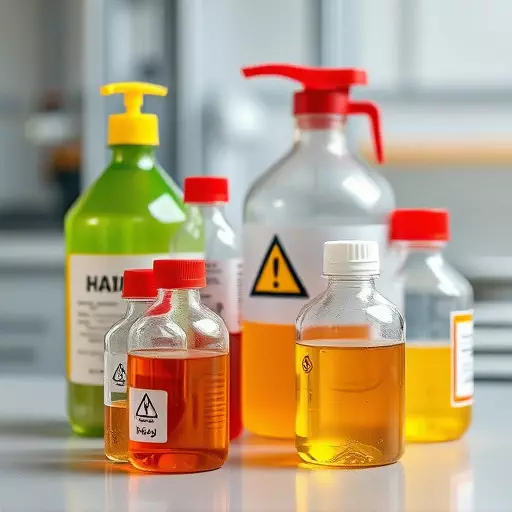Chemical exposure risk management is a critical component of industrial safety, focusing on identifying, assessing, and mitigating hazardous materials. The process begins with thorough identification of chemicals, their uses, and exposure routes through advanced surveys and analyses. Subsequent risk evaluation considers toxicity, concentration, and duration of exposure. Effective strategies include engineering controls, administrative measures, and personal protective equipment (PPE), enhancing industrial hygiene protocols. Meticulous hazardous material identification is a cornerstone of these protocols, empowering organizations to implement targeted control plans, conduct regular training, and foster safety awareness to minimize chemical exposure risks and create safer working environments.
In today’s industrial landscape, effective chemical exposure control plans are paramount for ensuring worker safety. This comprehensive guide delves into the crucial aspects of chemical exposure risk management, highlighting the foundational role of industrial hygiene protocols in protecting employees from harmful substances. We explore the process of hazardous material identification, emphasizing its importance in uncovering invisible threats. Additionally, we provide a step-by-step approach to developing, implementing, and continually improving exposure control strategies for optimal workplace safety.
- Understanding Chemical Exposure Risk Management: A Foundation for Safety
- Industrial Hygiene Protocols: The Cornerstone of Worker Protection
- Hazardous Material Identification: Unveiling the Invisible Threats
- Developing a Comprehensive Exposure Control Plan
- Implementation and Training: Ensuring Adherence and Awareness
- Monitoring, Evaluation, and Continuous Improvement Strategies
Understanding Chemical Exposure Risk Management: A Foundation for Safety
Chemical exposure risk management forms the cornerstone of any comprehensive industrial safety program. It involves a systematic approach to identify, assess, and mitigate potential hazards associated with chemical substances in the workplace. By implementing robust industrial hygiene protocols, organizations can ensure that employees are protected from the harmful effects of hazardous materials.
The initial step in this process is thorough hazardous material identification. This entails conducting detailed surveys and analyses to pinpoint all chemicals present in operations, their uses, and potential exposure routes. Once identified, these substances are evaluated based on their toxicity, concentration, and duration of exposure to determine the associated risks. Effective risk management strategies can include engineering controls (such as ventilation systems), administrative measures (like work practice changes), and personal protective equipment (PPE) to create a multi-layered defense against chemical exposures, fostering a safer working environment.
Industrial Hygiene Protocols: The Cornerstone of Worker Protection
Industrial Hygiene protocols form the cornerstone of worker protection against chemical exposure risks. These comprehensive strategies involve a multi-faceted approach to identify, assess, and mitigate hazardous materials present in the work environment. By implementing robust industrial hygiene practices, organizations can effectively manage chemical exposure risk management.
The process begins with meticulous hazardous material identification, where professionals conduct thorough inspections and utilize advanced techniques to detect even subtle traces of potentially dangerous substances. Once identified, these hazards are meticulously evaluated to understand their potential impact on workers’ health. This data informs the development of tailored industrial hygiene protocols, ensuring that protective measures align with the specific risks at hand.
Hazardous Material Identification: Unveiling the Invisible Threats
In the realm of chemical exposure risk management, the first step in mitigating potential dangers is understanding what hazards are present. Hazardous material identification is a crucial aspect of industrial hygiene protocols, as it involves recognizing and cataloging substances that pose risks to workers’ health and safety. These materials can be invisible to the naked eye, making their discovery and classification all the more vital. By employing advanced techniques, such as chemical analysis and digital databases, organizations can uncover the hidden threats lurking within their work environments.
Through thorough hazardous material identification, companies can implement targeted strategies for control and management. This process encompasses identifying sources of exposure, evaluating the potential impact, and selecting appropriate controls to minimize or eliminate risks. Effective industrial hygiene protocols rely on this foundational step, ensuring that workplaces are safe for employees while promoting operational efficiency.
Developing a Comprehensive Exposure Control Plan
Developing a Comprehensive Exposure Control Plan is an integral step in mitigating chemical exposure risk management within any industrial setting. It involves a systematic approach to identifying and evaluating hazardous materials present in the workplace, coupled with implementing effective industrial hygiene protocols. The primary goal is to minimize or eliminate employees’ direct contact with harmful substances, ensuring their safety and health over the long term.
This process begins with thorough hazardous material identification, where every chemical and substance used or stored on-site is meticulously cataloged. Once identified, risk assessments are conducted to determine the potential exposure risks associated with each material. Based on these findings, appropriate control measures can be implemented, such as engineering controls (e.g., ventilation systems), administrative controls (e.g., job rotation), and personal protective equipment (PPE). Regular reviews and updates of the plan are essential to adapt to changing workplace conditions and new industrial hygiene best practices.
Implementation and Training: Ensuring Adherence and Awareness
Implementing a chemical exposure control plan (CECP) is only half the battle; ensuring adherence and fostering awareness among all employees is crucial for effective risk management. Training plays a pivotal role in this regard, as it equips workers with the knowledge to identify hazardous materials, understand their potential risks, and follow safety protocols. Regular, comprehensive training sessions can help maintain a strong safety culture, encouraging everyone to stay vigilant and proactive.
This involves clear communication of industrial hygiene practices, including proper handling procedures, personal protective equipment (PPE) usage, and emergency response plans. By regularly updating employees on new or revised hazards, exposure limits, and control measures, organizations can ensure that everyone remains informed and prepared. This proactive approach to chemical exposure risk management not only protects workers’ health but also aligns with best practices in industrial hygiene protocols.
Monitoring, Evaluation, and Continuous Improvement Strategies
Effective chemical exposure control plans incorporate monitoring, evaluation, and continuous improvement strategies to manage risks and ensure adherence to industrial hygiene protocols. Regular air quality testing and personal protective equipment (PPE) assessments are key components of monitoring, allowing for real-time data on hazardous material identification and concentration levels. Evaluation involves analyzing this data against safety standards and regulatory requirements, identifying areas for enhancement, and implementing necessary changes.
Continuous improvement requires a proactive approach, where organizations regularly review their exposure control measures and incorporate innovative solutions. This may include adopting new technologies for better hazard detection and control, conducting employee training on best practices, and fostering a culture of safety awareness. By integrating these strategies, businesses can optimize industrial hygiene protocols, minimize chemical exposure risk management, and create a safer working environment.


